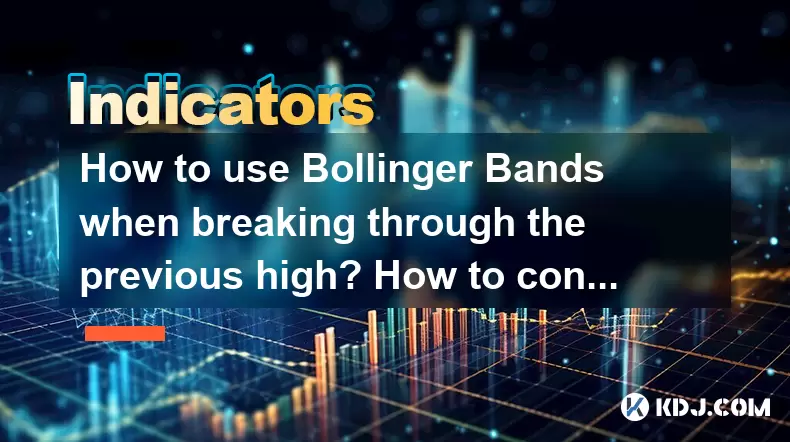-
 bitcoin
bitcoin $122659.385674 USD
0.52% -
 ethereum
ethereum $4484.113342 USD
-0.09% -
 bnb
bnb $1304.229256 USD
-0.85% -
 tether
tether $1.000204 USD
-0.03% -
 xrp
xrp $2.860636 USD
-0.51% -
 solana
solana $227.288799 USD
2.36% -
 usd-coin
usd-coin $0.999805 USD
0.01% -
 dogecoin
dogecoin $0.252837 USD
1.18% -
 tron
tron $0.341149 USD
1.12% -
 cardano
cardano $0.830507 USD
0.33% -
 hyperliquid
hyperliquid $45.792319 USD
0.04% -
 chainlink
chainlink $22.422164 USD
1.55% -
 ethena-usde
ethena-usde $1.000283 USD
0.01% -
 sui
sui $3.511389 USD
0.83% -
 stellar
stellar $0.385276 USD
-0.44%
How to use Bollinger Bands when breaking through the previous high? How to confirm a true breakthrough?
Bollinger Bands help crypto traders spot true breakouts when prices exceed previous highs, using volume and other indicators for confirmation.
May 21, 2025 at 07:56 pm

Bollinger Bands are a powerful technical analysis tool used by many cryptocurrency traders to identify potential price breakouts and confirm true breakthroughs. When breaking through the previous high, Bollinger Bands can provide valuable insights into market volatility and potential price movements. In this article, we will explore how to use Bollinger Bands effectively when a cryptocurrency breaks through its previous high and how to confirm a true breakthrough.
Understanding Bollinger Bands
Bollinger Bands consist of three lines: a simple moving average (SMA) in the middle, an upper band, and a lower band. The upper and lower bands are typically set two standard deviations away from the SMA. This setup helps traders visualize the volatility of the asset and potential price levels where breakouts might occur.
The middle band, often a 20-day SMA, represents the average price over a given period. The upper and lower bands adjust dynamically based on the asset's volatility. When the bands widen, it indicates increased volatility, and when they narrow, it suggests decreased volatility.
Identifying a Breakthrough with Bollinger Bands
When a cryptocurrency price breaks through its previous high, Bollinger Bands can help traders identify whether this move is a true breakthrough or a false signal. Here's how to use Bollinger Bands in this scenario:
Price touching or crossing the upper band: When the price touches or crosses the upper Bollinger Band, it indicates that the asset is experiencing significant upward momentum. This can be a sign of a potential breakthrough.
Volume confirmation: A true breakthrough should be accompanied by a significant increase in trading volume. High volume suggests that many traders are participating in the move, increasing the likelihood of a sustained price increase.
Sustained movement above the upper band: A true breakthrough often results in the price staying above the upper Bollinger Band for an extended period. If the price quickly returns within the bands, it might be a false breakout.
Confirming a True Breakthrough
To confirm a true breakthrough when using Bollinger Bands, traders should look for additional indicators and signals. Here are some methods to confirm a breakthrough:
Candlestick patterns: Look for bullish candlestick patterns such as the bullish engulfing pattern or hammer at the point of the breakthrough. These patterns can reinforce the likelihood of a true breakthrough.
Relative Strength Index (RSI): The RSI can help identify overbought conditions. If the RSI is not in the overbought territory (typically above 70) during the breakthrough, it may indicate that the upward momentum is sustainable.
Moving Average Convergence Divergence (MACD): A bullish crossover in the MACD, where the MACD line crosses above the signal line, can confirm the strength of the breakthrough.
Setting Up Bollinger Bands on Trading Platforms
To effectively use Bollinger Bands when breaking through the previous high, you need to set them up correctly on your trading platform. Here's how to do it on some popular platforms:
TradingView:
- Open a chart of the cryptocurrency you are interested in.
- Click on the 'Indicators' button at the top of the chart.
- Search for 'Bollinger Bands' and select it.
- Adjust the settings to your preference, such as the period for the SMA (usually 20) and the standard deviation (usually 2).
Binance:
- Navigate to the trading page for the cryptocurrency pair you want to analyze.
- Click on the 'Indicators' tab on the chart.
- Select 'Bollinger Bands' from the list of available indicators.
- Customize the settings as needed, typically keeping the default settings of a 20-period SMA and 2 standard deviations.
Coinbase Pro:
- Go to the trading page for your chosen cryptocurrency pair.
- Click on the 'Indicators' icon on the chart.
- Choose 'Bollinger Bands' from the dropdown menu.
- Adjust the settings to your liking, usually sticking with the standard 20-period SMA and 2 standard deviations.
Trading Strategies Using Bollinger Bands
When a cryptocurrency breaks through its previous high, traders can use Bollinger Bands to develop effective trading strategies. Here are some strategies to consider:
Breakout trading: When the price breaks above the upper Bollinger Band, traders can enter a long position, expecting the price to continue rising. Set a stop-loss order below the recent low to manage risk.
Trend following: If the price consistently stays above the upper Bollinger Band, it may indicate a strong uptrend. Traders can use this as a signal to hold onto their long positions and potentially add to them as the trend continues.
Mean reversion: If the price briefly breaks above the upper Bollinger Band but quickly returns within the bands, it could signal a mean reversion opportunity. Traders can enter short positions, expecting the price to return to the middle band.
Risk Management and Bollinger Bands
Effective risk management is crucial when using Bollinger Bands to trade breakouts. Here are some tips to manage risk:
Set stop-loss orders: Always set a stop-loss order to limit potential losses. For a long position after a breakthrough, place the stop-loss below the recent low or the lower Bollinger Band.
Position sizing: Adjust your position size based on the volatility indicated by the Bollinger Bands. Wider bands suggest higher volatility, so consider smaller position sizes to manage risk.
Diversification: Don't rely solely on Bollinger Bands. Use them in conjunction with other indicators and analysis methods to increase the accuracy of your trading decisions.
FAQs
Q1: Can Bollinger Bands be used for short-term trading?Yes, Bollinger Bands can be used for short-term trading. Traders often use shorter periods for the SMA (such as 10 or 5 days) to capture more immediate price movements. However, short-term trading with Bollinger Bands requires careful risk management due to the increased volatility.
Q2: How do Bollinger Bands perform in a sideways market?In a sideways market, Bollinger Bands tend to narrow, indicating low volatility. Traders can use this as a signal to prepare for potential breakouts when the bands start to widen. However, trading in a sideways market with Bollinger Bands requires patience and careful monitoring of other indicators.
Q3: Are Bollinger Bands effective for all cryptocurrencies?Bollinger Bands can be effective for most cryptocurrencies, but their performance may vary based on the asset's liquidity and volatility. More liquid assets tend to provide more reliable signals with Bollinger Bands. For less liquid cryptocurrencies, the bands might produce more false signals.
Q4: Can Bollinger Bands be used to predict market reversals?While Bollinger Bands can indicate potential reversals when the price touches or crosses the bands, they should not be used as the sole predictor of market reversals. Combining Bollinger Bands with other indicators like the RSI or MACD can provide a more comprehensive view of potential reversals.
Disclaimer:info@kdj.com
The information provided is not trading advice. kdj.com does not assume any responsibility for any investments made based on the information provided in this article. Cryptocurrencies are highly volatile and it is highly recommended that you invest with caution after thorough research!
If you believe that the content used on this website infringes your copyright, please contact us immediately (info@kdj.com) and we will delete it promptly.
- XRP Tokens: Can Owning Them Actually Make You Rich, Ya Know?
- 2025-10-09 18:45:15
- ADA Whales: Riding the Support Wave to Potential Gains?
- 2025-10-09 18:25:16
- H Mining: Navigating Crypto Investing with Risk Mitigation
- 2025-10-09 18:45:15
- Riding the Crypto Rollercoaster: IPO Genie, Crypto Presales, and Liquidation Lessons
- 2025-10-09 18:25:16
- MetaMask Goes Big: Perpetual Trading, Polymarket, and a Whole New DeFi Playground
- 2025-10-09 18:30:02
- Citibank, Stablecoins, and BVNK: A New York Minute on Wall Street's Crypto Moves
- 2025-10-09 18:30:02
Related knowledge

What is a tower bottom candlestick pattern? Does it have a high success rate?
Sep 22,2025 at 07:18am
Tower Bottom Candlestick Pattern Explained1. The tower bottom candlestick pattern is a reversal formation that typically appears at the end of a downt...

What is a black hole pattern in the MACD indicator? Is it a cause for concern?
Sep 21,2025 at 06:54pm
Bitcoin's Role in Decentralized Finance1. Bitcoin remains the cornerstone of decentralized finance, serving as a benchmark for value and security acro...

How can I use the psychological line (PSY) to determine market sentiment?
Sep 17,2025 at 02:19pm
Understanding the Psychological Line (PSY) in Cryptocurrency TradingThe Psychological Line, commonly referred to as PSY, is a momentum oscillator used...

How can I determine if a double top pattern has officially formed?
Sep 21,2025 at 03:18am
Understanding the Structure of a Double Top Pattern1. A double top pattern consists of two distinct peaks that reach approximately the same price leve...

What is the Golden Valley pattern on the moving average? Is it better than the Silver Valley pattern?
Sep 21,2025 at 02:54pm
Understanding the Golden Valley Pattern in Moving Averages1. The Golden Valley pattern is a technical formation observed in cryptocurrency price chart...

What does a death cross of the RSI in the strong zone (above 50) mean?
Sep 17,2025 at 10:54pm
Understanding the Death Cross in RSI Context1. The term 'death cross' is traditionally associated with moving averages, where a short-term average cro...

What is a tower bottom candlestick pattern? Does it have a high success rate?
Sep 22,2025 at 07:18am
Tower Bottom Candlestick Pattern Explained1. The tower bottom candlestick pattern is a reversal formation that typically appears at the end of a downt...

What is a black hole pattern in the MACD indicator? Is it a cause for concern?
Sep 21,2025 at 06:54pm
Bitcoin's Role in Decentralized Finance1. Bitcoin remains the cornerstone of decentralized finance, serving as a benchmark for value and security acro...

How can I use the psychological line (PSY) to determine market sentiment?
Sep 17,2025 at 02:19pm
Understanding the Psychological Line (PSY) in Cryptocurrency TradingThe Psychological Line, commonly referred to as PSY, is a momentum oscillator used...

How can I determine if a double top pattern has officially formed?
Sep 21,2025 at 03:18am
Understanding the Structure of a Double Top Pattern1. A double top pattern consists of two distinct peaks that reach approximately the same price leve...

What is the Golden Valley pattern on the moving average? Is it better than the Silver Valley pattern?
Sep 21,2025 at 02:54pm
Understanding the Golden Valley Pattern in Moving Averages1. The Golden Valley pattern is a technical formation observed in cryptocurrency price chart...

What does a death cross of the RSI in the strong zone (above 50) mean?
Sep 17,2025 at 10:54pm
Understanding the Death Cross in RSI Context1. The term 'death cross' is traditionally associated with moving averages, where a short-term average cro...
See all articles










































































